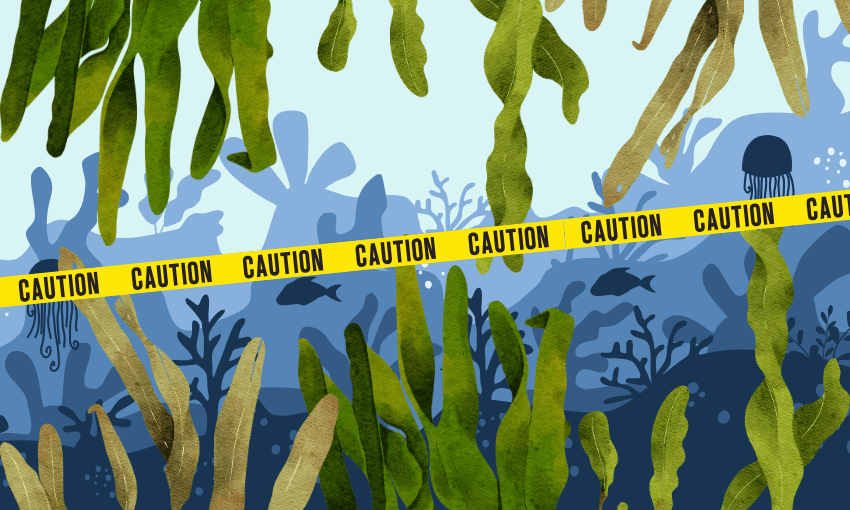Despite the growing threat of caulerpa and its potential to decimate our marine and tourism industries, the government still hasn’t classified it as a national pest.
Following the barrage of Cyclone Tam two weeks ago, hundreds of tonnes of caulerpa washed up on beaches near Rawhiti, on the far north east coast of the North Island. Recognising the need to respond quickly, local hapū Ngāti Kuta and Te Patukeha put out the call to the iwi of Te Tai Tokerau for urgent help. And the iwi responded, with dozens travelling from around the region to lend a hand with the removal of the invasive algae.
Described as the “cancer of the sea” and “a national emergency”, exotic caulerpa is a fast-growing green seaweed found in warm, shallow marine environments. Some species (like caulerpa brachypus, the exotic species in New Zealand) are invasive, spreading rapidly and outcompeting native marine life. Caulerpa can blanket the seabed, suffocating native species and altering ecosystems. Its rapid growth and resistance to grazing make it especially difficult to eradicate once established.
“The whole bay was smothered in it. It was heartbreaking,” said Viki Heta, one of the frontline responders, at a recent hui called to discuss the response of Te Tai Tokerau hapū to the caulerpa epidemic.
Native to tropical and subtropical waters of the Pacific, Indian Ocean, and parts of the Mediterranean, officials don’t know exactly where or when the toxic, sticky green algae first entered New Zealand waters, but it is believed to have arrived on a vessel travelling from Australia or the Pacific.
Despite being initially discovered on the west coast of Aotea in the outer Hauraki Gulf in July 2021, the Ministry for Primary Industries says the amount of caulerpa found in various locations around the North Island suggests it had already been here for several years. Currently, Caulerpa is known to be as far north as the Bay of Islands and as far south as Ahuahu island off the coast of the Coromandel peninsula. While Ngāti Wai are leading the fight against Caulerpa in the Hauraki and surrounds, the battle up north is a cross-iwi effort.
In February this year, biosecurity minister Andrew Hoggard announced funding of $6.2m to assist with development of the technology to help control the spread of caulerpa. However, that only brings total government funding to approximately $15m over four years, compared to the $100m Northland Regional Council says is needed to tackle the issue. The funding appears relatively minuscule next to the industry figures most at risk if caulerpa is not swiftly dealt with. The fishing industry is worth around $5.2 bn annually in economic output and the marine tourism industry is worth approximately $2.1 bn annually.
“If we don’t act now, we could lose our fisheries within a generation,” said hui organiser Nyree Manuel to the meeting of iwi and hapū leaders from Te Tai Tokerau. “This is bigger than just one rohe – this is a threat to Aotearoa.”
However, despite the efforts of iwi leaders such as Te Rūnanga o Te Rarawa chief executive George Riley to have caulerpa classified a national pest species – which would mean the government would have to develop and adequately resource a national pest management plan – caulerpa remains off the list and funding is still comparatively low next to the likes of kauri dieback.
“The response so far has been research-heavy and light on action,” said Jaycee Tipene-Thomas, who’s worked closely with hapū and biosecurity agencies. “MPI keeps asking for more time, but caulerpa spreads by the tide – it doesn’t wait.”
Caulerpa continues to spread like a benthic wildfire, destroying anything in its path. While the events following Cyclone Tam spurred hapū from across Te Tai Tokerau into action, key figures behind the scenes recognised that a more organised and intentional plan was required if ongoing meaningful impact was to be achieved. This led to a hui being held late last week to discuss a joint Te Tai Tokerau caulerpa response plan.
The hui was a gathering of heavy hitters from the north and beyond. Former Labour MP-turned-consultant Kelvin Davis was on the call, as were several iwi, hapū and marae leaders from throughout Te Tai Tokerau. Labour MP and biosecurity spokesperson Jo Luxton was there, alongside Māori Crown relations minister Tama Potaka. Despite several questions being asked about his government’s perceived lack of meaningful action in this space, Potaka did not speak,. The hui established that a draft response plan with hapū-led roles, hygiene protocols and team structures was required; it called for urgent government support and iwi inclusion; and emphasised education, coordination and the need for national pest recognition of caulerpa.
“Our hapū and iwi are already organised,” said Te Aupōuri chief executive Tipene Kapa-Kingi. “It’s time for the government to catch up – and front up – with real resources. We’re moving ahead with or without them.”
Without urgent and meaningful government support, there are fears caulerpa will continue to wreak havoc on the seafloor and threaten an environment vital to two of the county’s most prominent industries. Until then, iwi, hapū and community organisations continue to fight against the invasive pest with the few resources they do have. Unfortunately, without adequate resourcing and despite their best efforts, the fight may be in vain.
“The castings on the beach are just the tip,” said Riley. “If we don’t eradicate it underwater, we risk wiping out entire ecosystems – and the livelihoods that depend on them.”
This is Public Interest Journalism funded by NZ On Air.


